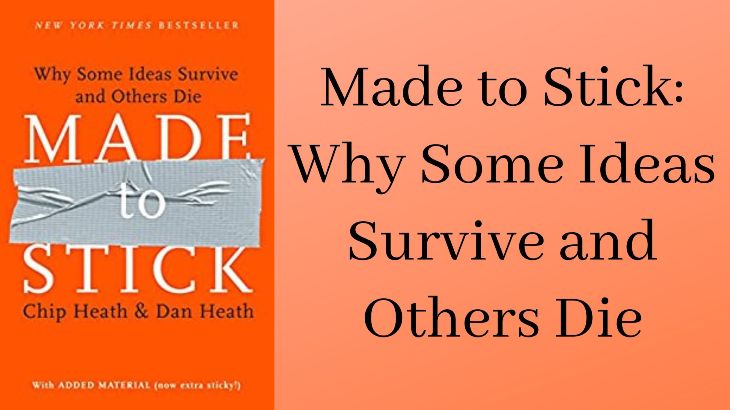Made to Stick: Why Some Ideas Survive and Others Die by brothers Chip and Dan Heath is a winner. I highly recommend it to people who what to learn how to become better story tellers and how to tell stories that stick.
The book was published on January 2, 2007. The book continues the idea of “stickiness” popularized by Malcolm Gladwell in The Tipping Point, seeking to explain what makes an idea or concept memorable or interesting. A similar style to Gladwell’s is used, with a number of stories and case studies followed by principles.
The stories range from urban legends, such as the “Kidney Heist” in the introduction; to business stories, as with the story of Southwest Airlines, “the low price airline”; to inspirational, personal stories such as that of Floyd Lee, a passionate mess hall manager.
Each chapter includes a section entitled “Clinic”, in which the principles of the chapter are applied to a specific case study or idea to demonstrate the principle’s application.
A man wakes up after a night of drinking in a bathtub with a kidney missing. A bird in the hand is worth two in a bush. Halloween candy spiked with razor blades. What do these urban legends and proverbs have in common? They are all ideas or stories that stick with us; easy to remember, easy to retell, and requiring no evidence or advertising for them to remain in the public consciousness. For example, the proverb “Where there’s smoke there’s fire” is found in 55 different languages. Where did it come from? Why does it resonate throughout dozens of languages and cultures? Why do we remember it?
Interested in understanding how they could develop and identify successful ideas, Chip Heath, a Professor of Organizational Behavior in the Graduate School of Business at Stanford University, and Dan Heath, a consultant and entrepreneur, have written an easily accessible and highly engaging book that draws upon numerous examples from the business world and evidence gathered from the scientific literature.
Defining an idea that sticks as one that is remembered, understood, and has a lasting impact, the book offers the simple acronym SUCCESs to both create and identify “sticky” ideas.
Very briefly, the acronym formula is:
- Simple: Locating the core of an idea and then translating that core. It is not about using fewer words or dumbing down a concept. The use of analogies or schemas is helpful; proverbs are an excellent illustration of this.
- Unexpected: Often the simplest way to get attention is by breaking away from a pattern. Present ideas that create some mystery. Studies have shown that by leaving a gap in someone’s knowledge, people are more likely and more inclined to seek out the answer.
- Concreteness: When ideas are presented in the abstract they are much harder to grasp. Grounding the idea by eliminating ambiguity and using numerous examples assists people in grasping new or unfamiliar concepts.
- Credibility: When ideas come from people we trust, their stories become more believable. Using vivid details helps increase credibility.
- Emotional: Make your idea or topic something that people care about. Explain to them the real benefit of learning a new idea (what is in it for them?).
- Stories: Stories are a different medium for sharing knowledge. They help us to simulate knowledge in our minds, and can demonstrate relationships between ideas we may not have known existed.
Each of these sticky traits is explored in depth by the authors, and the book contains rich examples. Demonstrating that their formula works, the numerous stories help to clearly illustrate concepts and make them much easier to remember for future use. The authors posit that the Curse of Knowledge is tightly linked with the SUCCESs formula, and is a primary reason why the transmission of ideas and concepts from a teacher to a student can be troublesome.
As described in the book, the Curse of Knowledge is what makes ideas hard to stick; once we know something, we have difficulty imagining what it is like to not know it. Since we have trouble imaging that state of not knowing, we struggle with the ability to recreate our learners’ state of mind. As the authors fully delve into explaining the characteristics of the SUCCESs formula, overcoming the curse and making ideas memorable is what drives the remainder of the book.
While many of the ideas/strategies presented in the book are famous examples of successful marketing or communication (e.g., Jared of Subway Restaurants fame), the Heaths argue that any idea, even if it is not groundbreaking or exciting, can be made to stick using the formula. Equally important, especially for those who are not strong public speakers, is the discovery that the skill of the speaker has little correlation with their ability to make an idea stick.
Other book reviews
- Lean In: Women, Work, and the Will to Lead by Sheryl Sandberg: Book Review
- The life of Malcolm X by Les Payne (Book review)
- Den of Thieves by James B. Stewart (Book Review)
